| dc.contributor.advisor | Marston, Richard A. | |
| dc.contributor.advisor | Storm, Daniel E. | |
| dc.contributor.author | Kang, Ranbir Singh | |
| dc.date.accessioned | 2013-11-26T08:24:06Z | |
| dc.date.available | 2013-11-26T08:24:06Z | |
| dc.date.issued | 2007-12 | |
| dc.identifier.uri | https://hdl.handle.net/11244/6771 | |
| dc.description.abstract | This research evaluates the impact of urbanization on channel morphology of three streams in the Central Redbed Plains geomorphic province (Central Great Plains ecoregion) of Oklahoma. The Deep Fork Creek watershed is largely urbanized; the Skeleton Creek watershed is largely rural; and the Stillwater Creek watershed is experiencing a rapid transition from rural to urban land cover. Each channel was divided into reaches based on tributary junctions, sinuosity, and slope. Field surveys were conducted at transects in a total of 90 reaches, including measurements of channel units, channel cross-section at bankfull stage, and riparian vegetation. Historical aerial photographs were available for only Stillwater Creek watershed, which were used to document land cover in this watershed, especially changes in the extent of urban areas (impervious cover). | |
| dc.description.abstract | The three streams have very low gradients (< 0.001), width-to-depth ratios < 10, and cohesive channel banks, but have incised into red Permian shales and sandstone. The riparian vegetation is dominated by cottonwoods, ash, and elm trees that provide a dense root mat on stream banks where the riparian vegetation is intact. Channels increased in the downstream direction as is normally expected, but the substrate materials and channel units remained unchanged. Statistical analyses demonstrated that urbanization provides minimal explanation for spatial patterns of changes in any variables. These three channels in the Central Redbed Plains are responding as flumes during peak flows, funneling runoff and the wash-load sediment downstream in major runoff events without any effect on channel dimensions. Therefore, local geological conditions (similar bed rock, cohesive substrates and similar riparian vegetation) are mitigating the effects of urbanization. | |
| dc.format | application/pdf | |
| dc.language | en_US | |
| dc.rights | Copyright is held by the author who has granted the Oklahoma State University Library the non-exclusive right to share this material in its institutional repository. Contact Digital Library Services at lib-dls@okstate.edu or 405-744-9161 for the permission policy on the use, reproduction or distribution of this material. | |
| dc.title | Effects of urbanization on channel morphology of three streams in the Central Redbed Plains of Oklahoma | |
| dc.contributor.committeeMember | Wikle, Thomas A. | |
| dc.contributor.committeeMember | Lightfoot, Dale R. | |
| dc.contributor.committeeMember | Rao, Mahesh N. | |
| osu.filename | Kang_okstate_0664D_2510.pdf | |
| osu.accesstype | Open Access | |
| dc.type.genre | Dissertation | |
| dc.type.material | Text | |
| dc.subject.keywords | geomorphology | |
| dc.subject.keywords | channel morphology | |
| dc.subject.keywords | urbanization | |
| dc.subject.keywords | land cover | |
| thesis.degree.discipline | Geography | |
| thesis.degree.grantor | Oklahoma State University | |
